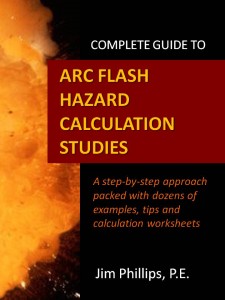Complete Guide to Arc Flash Hazard Calculation Studies
This book by Jim Phillips, P.E. takes Arc Flash to the next level by showing you how to perform the complete Arc Flash Hazard Calculation Study by using a very structured approach to take you through each step from beginning to end. Using a series of flow charts, examples and calculation worksheets developed by Jim, the study process is broken down into a detailed step by step approach. You will be taken through many solved problems and examples including arcing short circuit current, incident energy and arc flash boundary calculations. You will also see how to simplify the arc flash study and arc flash labeling as well as understand how to properly model the power system.
Many questions and potential problem areas are frequently encountered when performing the Arc Flash Study. Jim provides many tricks that can be used for the study and also warnings about the potential traps that could be encountered. You will also see how to successfully make assumptions and simplify the overall process. Although not yet part of any standard, this is the first book of it’s kind to include DC arc flash calculations and worksheets with many examples and illustrations based on a few well known technical papers.
Jim is Secretary of IEEE 1584 – IEEE Guide for Arc Flash Hazard Calculations and is the Liaison to Geneva, Switzerland based International Electro-Technical Commission’s (IEC) TC78/WG-15 – Arc Flash Protection, as well as a member of many other codes and standards committees. Jim is also the Head of the United States delegation for the IEC Technical Committee 78 – Live Working. All of this provides him with a very unique perspective from the insider’s view. His Arc Flash Training Courses have become the industry standard. Even instructors from other training companies have attended Jim’s classes to see how it’s done.
Table of Content
What is an Arc Flash?
Burn Injuries
Who Says I Have to Perform the Study?
OSHA CFR Title 29
NFPA 70E—Standard for Electrical Safety in the Workplace
Shock Hazard Analysis
Arc Flash Warning Labels
NFPA 70 National Electrical Code
Many Standards Define the Arc Flash Study and Protection Requirements
What is an Arc-Flash Hazard Calculation Study?
Why Perform the Arc-Flash Hazard Calculation Study?
Calculation Methods
The Study Process
Where Do I begin?
PPE To Wear During Data Collection
Single Line Diagrams
Jump Start the Project
Source Data
Impedance Data
Protective Device Data
Arc Flash Study Parameters
Type of Equipment
Data Assumptions
Equipment Condition and Maintenance
Developing the Single Line Diagram
Operating Scenarios
System Modeling
Comparison of Scenarios—Does the PPE Level Change?
What is a Short Circuit?
Short Circuit Study—Bolted Short Circuit Current
Simplified “Infinite Bus” Short Circuit Calculation
Comparison of Transformer kVA Rating and Short Circuit Current
Effect of the Source Impedance
Effect of the Conductors
Short Circuit Motor Contribution
Arcing Short Circuit vs. Bolted Short Circuit
Arcing Short Circuit Current Calculations
Arcing Short Circuit Calculations ≤ 1kV
Duration of Arc Flash Exposure
Factors Affecting Arc Flash Duration
Time Current Curves
Selective Coordination and Maintenance Settings
Transformer Secondary Blind Spot and Danger Areas
Over-current Device Age and Condition
Device Setting or Rating Changes
100% vs. 85% of Arcing Current
Incident Energy
Incident Energy Calculations ≤ 15 kV Three Phase
Incident Energy Calculations > 15 kV
Current Limiting Devices
Clearing Time is Everything
Arc Flash Boundary
IEEE 1584 Arc Flash Boundary < 15 kV
Arc Flash Boundary > 15 kV
Using Arc Flash Boundary Equations to determine the safe working distance for PPE
with a lower arc rating
Keeping Unprotected People Away
Keep it Simple! Standardized Arc Flash Protection Boundaries
Arc Flash is not Just an AC Problem
DC Arc Flash Calculations
DC Arc Flash Modeling
DC Arc Resistance Worksheet
Power and Energy in the Arc
DC Arc Flash in Open Air
DC Arc Flash in an Enclosure / Box
What’s Next?
Arc-Rated Clothing and PPE Selection
OSHA AR Clothing and PPE Requirements
NFPA 70E– AR Clothing and PPE Requirements
Method One—Incident Energy Analysis
Hazard/Risk Category Classification Table
Alternative to the Arc-Flash Hazard Calculation Study
NESC Arc-Rated Clothing and PPE Requirements
Incident Energy Greater Than 40 cal/cm2
Arc-Rated Clothing
Personal Protective Equipment
What’s Next?
Arc Flash Warning Label
What Information is required on the label?
Which Equipment requires a label?
What Colors and Signal Words are required?
Where are the Labels Located?
Labeling Multi-Section Equipment
Recommendations to Reduce Incident Energy
Protective Device Setting Changes to Reduce the Arc Flash Hazard
Protection Schemes to Reduce the Arc Flash Hazard
The Best Method
Put it in Writing
The Detailed Report
There WILL be Changes!
Get Everyone On Board!
Arc Flash and the Electrical Safety Program
How to Recognize the Arc Flash Hazard
Arc Flash Protection Boundary
Selection of Arc-Rated Clothing and PPE based on Study Results
Use of Arc Flash Warning Labels
Electrically Safe Work Condition
Energized Electrical Work Permit
Arc Flash and Electrical Safety Training
Finally
I am careful—It can’t happen to me!
Strange Statistics from My Arc Flash Training
The Final Word—Don’t Become a Statistic!
References
Appendix A: Acronyms
Appendix B: Data Collection Forms
Appendix C: Calculation Worksheets
Index






